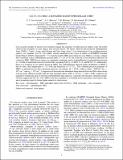Files in this item
G11.92-0.61-MM2 : a bonafide massive prestellar core?
Item metadata
| dc.contributor.author | Cyganowski, C.J. | |
| dc.contributor.author | Brogan, C.L. | |
| dc.contributor.author | Hunter, T.R. | |
| dc.contributor.author | Graninger, D. | |
| dc.contributor.author | Öberg, K.I. | |
| dc.contributor.author | Vasyunin, A. | |
| dc.contributor.author | Zhang, Q. | |
| dc.contributor.author | Friesen, R. | |
| dc.contributor.author | Schnee, S. | |
| dc.date.accessioned | 2017-02-07T13:30:33Z | |
| dc.date.available | 2017-02-07T13:30:33Z | |
| dc.date.issued | 2014-11-20 | |
| dc.identifier | 158739745 | |
| dc.identifier | 32bbf070-9d31-4d28-997e-f5e1f2a60501 | |
| dc.identifier | 84909965227 | |
| dc.identifier | 000344647000002 | |
| dc.identifier.citation | Cyganowski , C J , Brogan , C L , Hunter , T R , Graninger , D , Öberg , K I , Vasyunin , A , Zhang , Q , Friesen , R & Schnee , S 2014 , ' G11.92-0.61-MM2 : a bonafide massive prestellar core? ' , Astrophysical Journal Letters , vol. 796 , no. 1 , L2 . https://doi.org/10.1088/2041-8205/796/1/L2 | en |
| dc.identifier.issn | 2041-8205 | |
| dc.identifier.uri | https://hdl.handle.net/10023/10242 | |
| dc.description | Supported by NSF AAPF (C.J.C., AST-1003134) and ERC (A.V., PALs 320620). | en |
| dc.description.abstract | Core accretion models of massive star formation require the existence of stable massive starless cores, but robust observational examples of such objects have proven elusive. We report subarcsecond-resolution Submillimeter Array (SMA) 1.3 mm, 1.1 mm, and 0.88 mm and Very Large Array 1.3 cm observations of an excellent massive starless core candidate, G11.92–0.61-MM2, initially identified in the course of studies of GLIMPSE Extended Green Objects (EGOs). Separated by ~7 farcs 2 from the nearby MM1 protostellar hot core, MM2 is a strong, compact dust continuum source (submillimeter spectral index α = 2.6 ± 0.1), but is devoid of star formation indicators. In contrast to MM1, MM2 has no masers, no centimeter continuum, and no (sub)millimeter wavelength line emission in ~24 GHz of bandwidth observed with the SMA, including N2H+(3-2), HCO+(3-2), and HCN(3-2). Additionally, there is no evidence for an outflow driven by MM2. The (sub)millimeter spectral energy distribution of MM2 is best fit with a dust temperature of ~17-19 K and luminosity of ~5-7 L☉. The combined physical properties of MM2, as inferred from its dust continuum emission, are extreme: M ≳ 30 M☉ within a radius <1000 AU, NH_2 >1025 cm–2 and nH_2 >109 cm–3. Comparison of the molecular abundance limits derived from our SMA observations with gas-grain chemical models indicates that extremely dense (n(H) ≫ 108 cm–3), cold (<20 K) conditions are required to explain the lack of observed (sub)millimeter line emission, consistent with the dust continuum results. Our data suggest that G11.92–0.61-MM2 is the best candidate for a bonafide massive prestellar core found to date, and a promising target for future higher-sensitivity observations. | |
| dc.format.extent | 9 | |
| dc.format.extent | 1463479 | |
| dc.language.iso | eng | |
| dc.relation.ispartof | Astrophysical Journal Letters | en |
| dc.subject | Astrochemistry | en |
| dc.subject | ISM: individual objects (G11.92-0.61) | en |
| dc.subject | ISM: molecules | en |
| dc.subject | Stars: formation | en |
| dc.subject | Stars: protostars | en |
| dc.subject | Submillimeter: ISM | en |
| dc.subject | QB Astronomy | en |
| dc.subject | QC Physics | en |
| dc.subject | QD Chemistry | en |
| dc.subject.lcc | QB | en |
| dc.subject.lcc | QC | en |
| dc.subject.lcc | QD | en |
| dc.title | G11.92-0.61-MM2 : a bonafide massive prestellar core? | en |
| dc.type | Journal article | en |
| dc.contributor.institution | University of St Andrews. School of Physics and Astronomy | en |
| dc.identifier.doi | 10.1088/2041-8205/796/1/L2 | |
| dc.description.status | Peer reviewed | en |
This item appears in the following Collection(s)
Items in the St Andrews Research Repository are protected by copyright, with all rights reserved, unless otherwise indicated.

